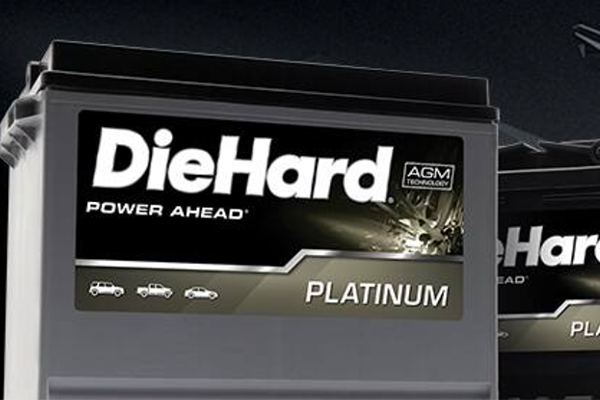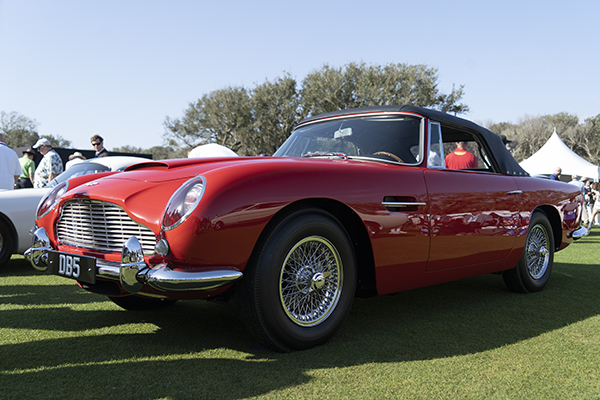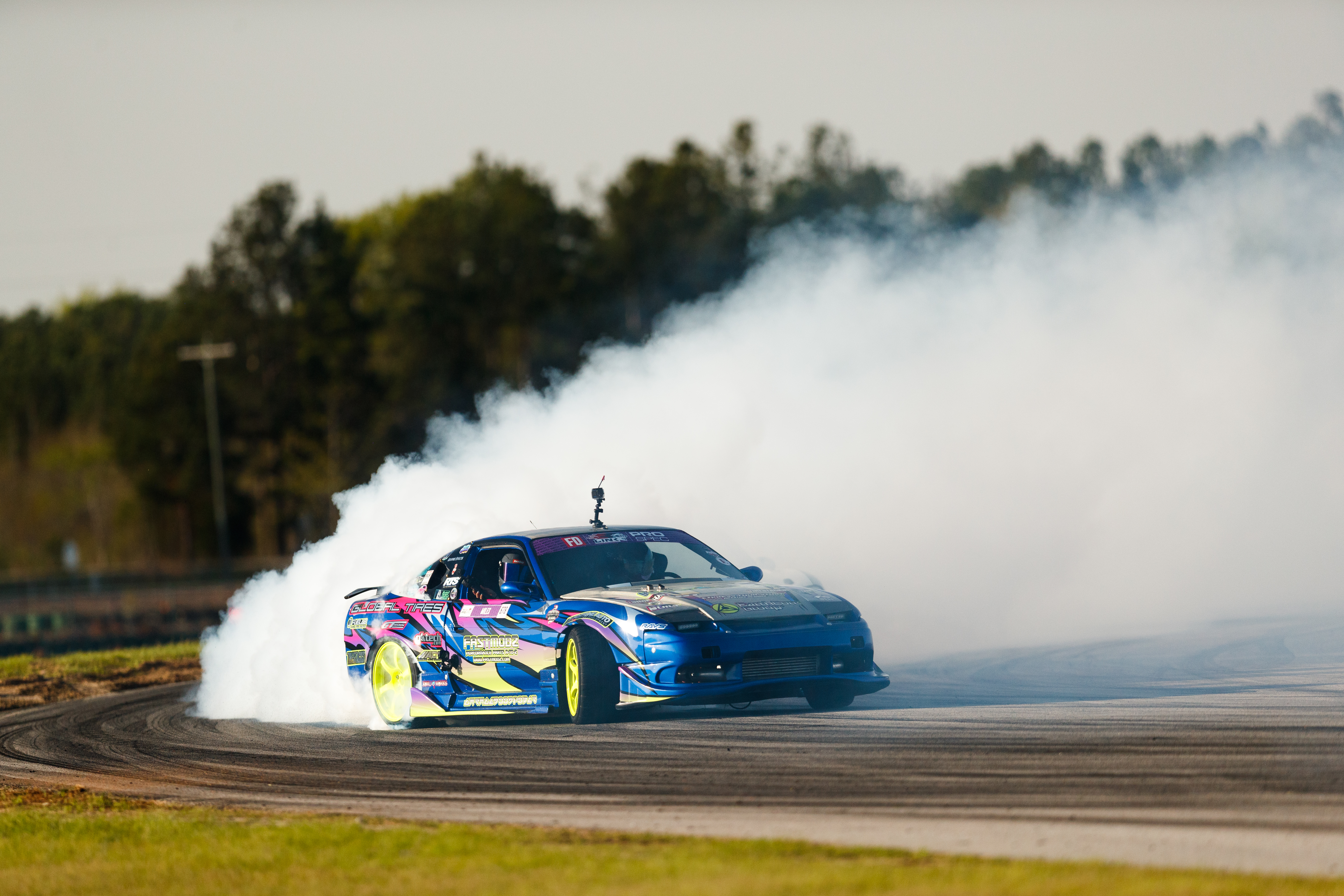"I consider myself to be a visual scientist, relentlessly exploring as many forms of artistic expression as I can. Sculpture is not my career, it’s my life. I am obsessed with creating as many new sculptures as possible."
So says Bruce Gray, renowned Los Angeles sculptor who uses discarded pieces of metal as the building blocks of his art. One of his most famous sculptures is Motorcycle 1 made out of recycled train and motorcycle parts.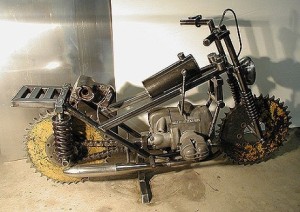 Photo credit: Bruce Gray.
Photo credit: Bruce Gray.
This sculpture stands 55” tall, is 94” long and 33” wide, which is slightly larger than a genuine ride-able motorcycle. It weighs somewhere between 700 and 800 pounds. Parts, all of which were “found,” include:
- “2 very heavy massive railroad equipment gears for wheels”
- “train coupling link for the seat”
- “giant train springs for shocks”
- “BMW R75/5 motorcycle engine and tailpipes”
He’d like to create similar motorcycle sculptures, but “there is always the matter of getting enough free time. When creating art from found objects, there is a big time investment, plus a sculpture of this size takes up lots of storage space.” One of Bruce’s dreams is to also create a ride-able version of this piece of art.
This sculpture appeared on Discovery Channel’s Monster House and was featured in Angeleno magazine, Art Business News magazine, The Fabricator magazine and on the back cover of the Chic Eco directory.
In fact, if we were to list all of the movies, television programs, music videos and commercials that feature Bruce’s work, we’d literally need to add nearly 1,000 words of text to this blog post (Yes. We checked.). And, that doesn’t count the numerous articles written about him in magazines and newspapers, or the large numbers of museums and prestigious art shows that spotlight his talent–or the well-known people who commission him to create art for their homes and offices.
Here is just a taste:
- Movies:
- Starship Troopers
- Rush Hour
- Gone in 60 Seconds
- Commercials:
- Chevrolet
- General Motors
- Mercedes Benz
- Music videos:
- Madonna
- Dr. Dre
- Wu Tang Clan
- Television shows:
- Seinfeld
- Star Trek: The Next Generation
- How I Met Your Mother
“I’ve also been asked to play a part in about a dozen or so reality shows,” he adds. “One of the most recent involves a bar with motorcycles that is still in the early stages of production and may not have even been presented to a network yet.” Here are more of his accomplishments.
The story behind the story
Born in 1956 in Orange, New Jersey, Bruce and his family moved to Belgium for a few years, starting when he was in first grade. They lived in an old hotel with six floors, a bomb shelter and a wine cellar. “We lived in the hotel by ourselves,” he recalls, “and it was a great place to play hide and seek.”
There is only so much hide and seek that a young boy can play, though, so he also kept himself busy creating stuff from Lincoln Logs, Tinker Toys, Legos and the like. He took apart radios to see how they worked and so forth. He also got to see the Atomium building in Brussels, a structure created out of stainless steel spheres that, when connected together, represent a cell of an iron crystal cell magnified 165 billion times. Bruce says that this building influenced him later as an artist.
“I sketched a lot in school, too,” he says. “I doodled since people often didn’t speak English and I didn’t know what anyone was saying.”
After the stay in Belgium, Bruce and his family returned to New Jersey, although he seldom saw his father, an international banker from Scotland who spent most of his time in Europe. “I might not see him,” Bruce says, “for a period of ten years.” Shortly before Bruce entered high school, his family moved to Massachusetts.
After high school ended (Bridgewater Raynham Regional High School, class of 1975), he joined the Coast Guard for four years. He then applied to the University of Massachusetts–but his art portfolio didn’t meet the minimum requirements. In fact, the only “art portfolio” that he had consisted of pieces of art that he’d put together that day in 30 minutes . . . meaning 30 minutes, total.
“I’d never done anything in the arts,” Bruce explains, “except for shop class. I was fairly good in that class, making an electric guitar from scratch without instruction. But, that was all I’d done. So, when I think back at how bad the portfolio I’d submitted to the university was, it’s amusing.”
The university recommended that he take art courses for a year and then reapply. Shortly afterwards, though, he received a notice saying that he should meet with the dean of the design department to discuss admission possibilities. Bruce’s raw talent impressed the dean enough that he was permitted to start his education under probation. To stay in the school, he needed to maintain a B average. “I’d already been in the military, though,” Bruce says, “and I was used to hard work and long hours. So, if a teacher said that he needed two examples of a certain piece of art within a week, I’d have three ready by the next morning–which really annoyed my classmates.”
Bruce attended the university from 1979 to 1983, earning a BFA in design. He then worked in Boston as a photographer and graphic designer. Although he found logo design satisfying, he longed for something more.
Pivotal event
In 1989, his mother died unexpectedly and suddenly of a brain aneurysm. “After that happened–literally, right after–I decided to quit what I was doing and get on with life. I realized that nobody gets to make the call about how long you stay on Earth so I decided to do what I really wanted to do.”
What exactly that was, he didn’t yet know. As a kid, he’d thought about becoming a marine biologist. “Or,” he says, “maybe a spy like James Bond–or maybe I’d work for Mad magazine.” Unclear about what precisely awaited him in life after his mother’s death, he drove to North Carolina and windsurfed for a week to clear his mind. He then drove to Mexico City and remained there until he got himself back on track.
What he ultimately decided: to move to California to create three dimensional, permanent pieces of art out of wood and metal. He quickly realized that he didn’t want to conceptualize a piece of art and then have someone else weld it together, so he bought a cheap piece of welding equipment and taught himself how to use it, which allowed him to take complete control of his own art. “I no longer have any artistic limitations,” he explains on his web page. “I have let my imagination take over.”
When recalling his earlier days as an artist, Bruce says that he’d sell five pieces of art one day–and then he would hear nothing from prospective buyers for so long that he’d start calling his own number just to see if it worked. He recalls one day where he literally had nothing to eat–that is, until he remembered that he’d bought a jar of peanut butter in case calamity struck during Y2K (when the year 2000 was ushered in). Checking out the jar, he saw that it was three years past its expiration date–and then he ate the peanut butter.
More of Bruce Gray’s art
“I create sculptures and functional art in welded steel, stainless steel, brass, copper, and aluminum. The works vary considerably and include swirl grinded bare metal intersecting geometric shapes sculptures, rusty found object assemblages, colorfully painted wall sculptures, mobiles, suspended magnetic sculptures, and powder coated bright colored sculptural tables and chairs. My work is usually fun, colorful, visually stimulating, and often conveys my sense of humor. My found object works may be people, animals, insects, or dinosaurs, and are stylized, simplified, and given their own unique personalities.”
Committed to protecting the environment, he is pleased that, overall, he puts less into dumpsters than he takes out. He also is amused that he can take something destined for the landfill and refashion it to hang on a “rich guy’s wall.”
Bruce has created fully functional chair sculptures from motorcycle parts, such as this EZ Rider Chair (30” x 65” x 24”).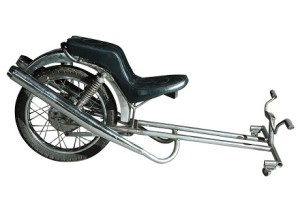 Photo credit: Bruce Gray.
Photo credit: Bruce Gray.
Bruce is also well known for his rolling ball sculptures, where a steel ball starts at the top of the sculpture and, through gravity alone, travels a path to the ground. In Cheborgie #1 (79” x 33” x 27”), the steel ball “follows a rollercoaster track, does jumps, goes down stairs, through chimes, past a spinner and through a tube.”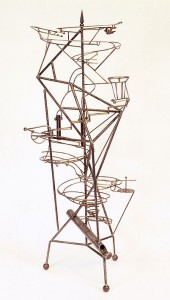 Photo credit: Bruce Gray.
Photo credit: Bruce Gray.
(You have to wonder how much the Atomium building in Belgium influenced his fascination with this type of sculpture!)
He is also well known for his high heel sculptures, such as “High Heel Shoe #4.” These sculptures have appeared in multiple magazines and on television and this particular one is 39” x 27” x 16”, crafted out of steel and coated with ten layers of high quality automotive enamels. Photo credit: Bruce Gray.
Photo credit: Bruce Gray.
Bruce shares the challenges of the artist’s life. “Most of us artists,” he says, “work alone every day. It can get tedious. It can drive you crazy, to the point where you absolutely have to get out of the house.” Here’s another challenge. “Most artists I know tend to be introverted to the point that it hurts their career. You need to promote your work one way or the other: hiring a PR person, getting an agent or being self-motivated enough to get attention for your work. Fortunately, I’d spent a lot of time in marketing because of my advertising background, so I know a bit about promotion. I don’t mind the work–and doing it myself is budget friendly.”
Another challenge faced by Bruce is that he is dyslexic, but he actually sees that as a blessing. “I grew up with dyslexia,” he shares, “but I was never diagnosed as a kid. It wasn’t until ten years ago that I was watching a show about dyslexia on the Discovery Channel and I thought, ‘Wait a minute. This is ridiculous. I have ALL of these symptoms.’"
He therefore did some research and found out that many household names, including some people considered geniuses, have been dyslexic. “It gives you a different way of thinking. You don’t piece together tiny parts of a problem. Instead, you see the big picture–and that sounds just like me. I rarely draw any piece of art out in advance. I just start making something. That’s how I work–and, in fact, how I prefer to work.”
In April of this year, Bruce had a surprise visit from the chancellor of the University of Massachusetts, where he’d earned his BFA. “He talked to me about commissioning a big sculpture for the school and about my flying back to give lectures. I’ve come a long way.”
When asked what the younger Bruce would have thought about today, he admits that he’d “be surprised at how hard the work is, and how much time I spend working,” adding that he’d like the following to be his legacy: “I would like to leave behind a great body of art, lots of really great friends, and also be known for my environmental work.”
Editor's note: Automotive maintenance can be an art unto itself. Shop Advance Auto Parts for the best deals and selection to get the job done. Buy online, pick up in-store—in 30 minutes.
